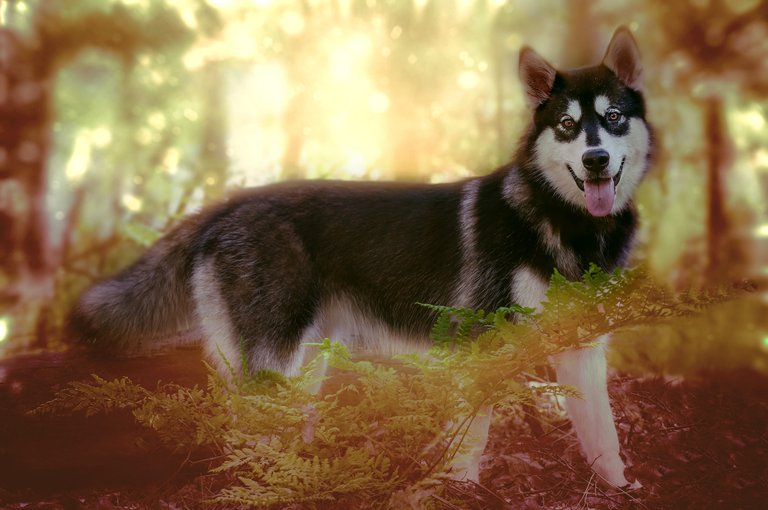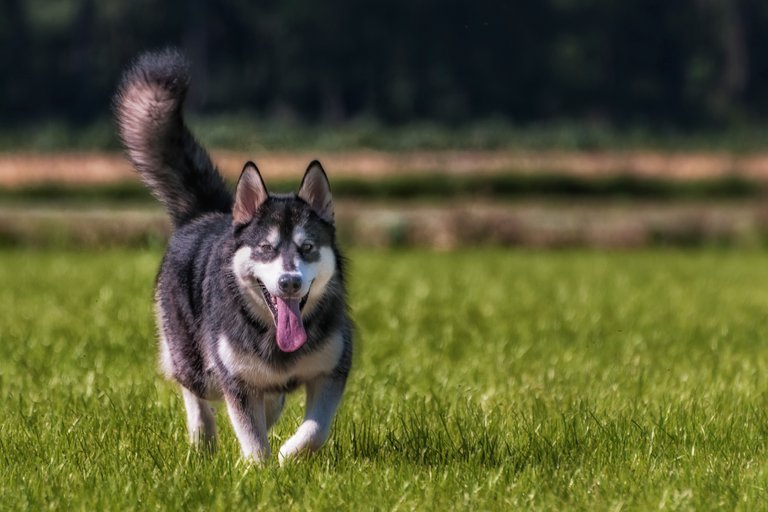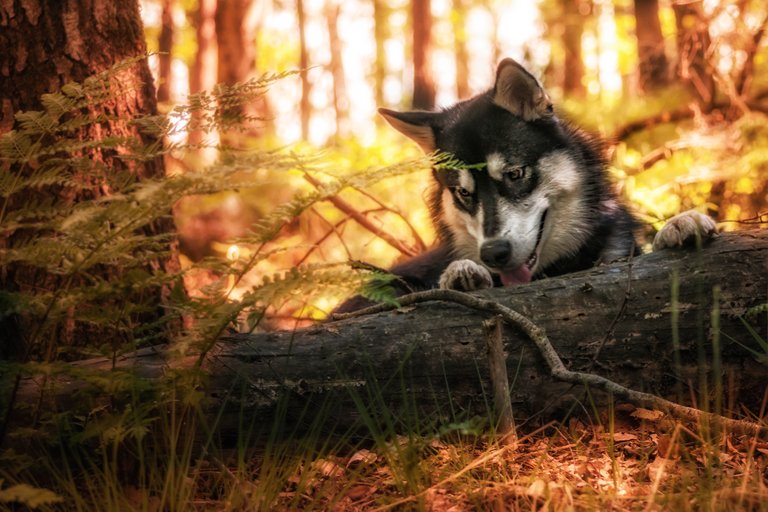Alaskan Malamute
Origin.
The Alaskan Malamute is a dog that has not been given its present appearance by man's involvement. The Alaskan Malamute is not bred as with many other breeds selected to give the dog its 'shape'. In contrast ... This dog has got its current form through natural selection, a ruthless selection that has developed in favor of the ones that had adapted best for the harsh living conditions in the High North. The Alaskan Malamute is therefore also the Pole Dog par excellence.
He got his breed name from an eskimo tribe in Alaska, the Mahlemuts. In itself, the name of this tribe means 'people who live in the place of the big waves'. This people lived around the Gulf of Kotzebue and Norton Bay and lived mainly from fishing. Their dogs were mainly used to tow boats along the banks and for the hunt for caribou. And that is still to be found in the current Malamute. The Russians and Americans who described life in the High North in the 19th century, and spent a while at the Eskimos, were all affected by the respect and affection with which the Eskimo's treated their dogs.
Yet this is not surprising. Because life in the High North is hard because of the extreme conditions there, the humans had to depend on the quality and health of their dogs for their survival! This explains why the Eskimos were committed to keeping their dogs as healthy as possible. Why they only bred with the best animals, the healthiest, the strongest animals. The animals that were best adapted to survive under these extreme conditions. A pleasant extra was that these dogs were not only excellent workers, but also in their temperament combined the useful with the attractive. They were very friendly, gentle and focused on people. Because of this they were not only valued as useful animals, but also as a pleasant and warm companion animal. You can see that very well in the films that were made at the Eskimos in the beginning of the 20th century.
Yet the Alaskan Malamute has also experienced very difficult times due to the gold rush. The gold rush almost killed the breed. When gold was found in parts of Alaska and the Eskimos had more permanent residences, there was less need for dogs. At the same time sled dog races became popular and Malamute's were crossed with European mountain breeds. The quality of the dogs deteriorated so that the breed almost went under.
By 1920 the first Alaskan Malamute's appeared in the United States. Breeding experienced an enormous impetus from some very enthusiastic fanciers, who knew how to bring the breed to the original high level. However, it took until 1935 before the American Kennel Club officially recognized the breed. In that year, the Alaskan Malamute Club was also established.
Although the Alaskan Malamute is fast, he can not compete against the other sleds in that respect. He must therefore be regarded more as the proverbial 'snow locomotive'. He exhibits a great sense of work and only feels comfortable with expressions of great strength and endurance.
Breed standard
Characteristic of this breed are an athletic construction and a great stamina. A harmonious movement is essential for the work of the Malamute. He is therefore effortless, without showing any irregularity. The trim is powerful and strong, the pass length is generous. The Malamute is a 'singletracker': in trot his feet come down to one line. A harmoniously built dog, with a matching front and hindquarters, will never run 'pinched' or place the hind legs next to the forelegs.
Difference between Malamute's and Huskies.
Of course it is too far to describe the entire breed standard. But it is interesting to note that many people exchange an Alaskan Malamute and a Husky with each other. While there is a clear difference to be found there. Some of the most obvious differences are.
- Malamute's are bigger.
- Malamute's may only appear in light gray with shades of black and sable, according to the breed standard. A sable may have a shading on red. With the exception of white, solid color malamutes are not allowed. Huskies may appear in any color according to the breed standard
- The eyes of a Malamute MUST be brown, the eyes of a Husky may be blue and brown.
- Malamute's are bred on endurance, Huskies are bred on speed and short explosions of power
Character.
The behavior of a pedigree dog depends mainly on the purpose for which it was originally bred. For the Malamute, that was mainly working and surviving under the harshest conditions. This still determines its current character: survival = first me and then you. It is a smart and strong dog. The Malamute can not be compared to, for example, the more popular shepherds or retrievers, and that is not for nothing: his temperament and the many primordial values he still possesses don't make him one of the easiest breeds. A Malamute owner must therefore take the necessary steps. Make great efforts to educate and guide his dog well. He does not live here in a vast polar region but in a densely populated environment to which he will have to adapt.
To unknown people, the Malamute is usually a passive or a friendly dog. This means that his behavior can vary from strangers to being indifferent, ignoring ("if you do not have any goodies with you") to a cuddly cuddler. He is absolutely not bred to protect his boss or the belongings of his boss: a well-socialized Malamute is almost never watchful or aggressive towards unknown people. Barking they will almost never do, most Malamute's can not even bark! Which doesn't mean that they don't make a sound. Enough very vocal Malamute's that yodel the ears of your head.
Where a Malamute to strangers will therefore mostly passively respond to friendly, this is the opposite of known people. Exactly those with whom the Malamute lives closely together, may have to deal with his dominant traits. A Malamute has a strong tendency to test the limits of its owners. Give him one finger, be inconsistent or too indulgent and he ultimately determines where you can go and stand. He knows exactly who he can go to. An adult dog of about 40 to 50 kg who sees that he can successfully use aggression should not be underestimated.
A Malamute really needs to be raised very consistently and clearly from a very young age, if he is still an 8 week old cute little wool ball. This doesn't mean that he necessarily requires a hard approach, but one with expertise.
So before the purchase, consider yourself well in dog behavior, language and upbringing. A Malamute owner must physically and mentally control the dog. Once grown up, a Malamute is too strong to turn the roles around.



Howdy partner, I'm @photocurator, a curation bot; I keep an eye on the photo feeds, I vote random photos of my followers and at the end of the day I publish a post with links to the best photos. Follow @photocurator to get your photos curated in the future!
Brilliant inside info for this breed. I had a cross malamute once and she was a loyal loving handful. 😊 Not a bed for the faint hearted or inexperienced just because it looks good. Want a pretty dog go for a motel with character not a malamute that needs to know her place as much as anything. Those with experience will reap great rewards.